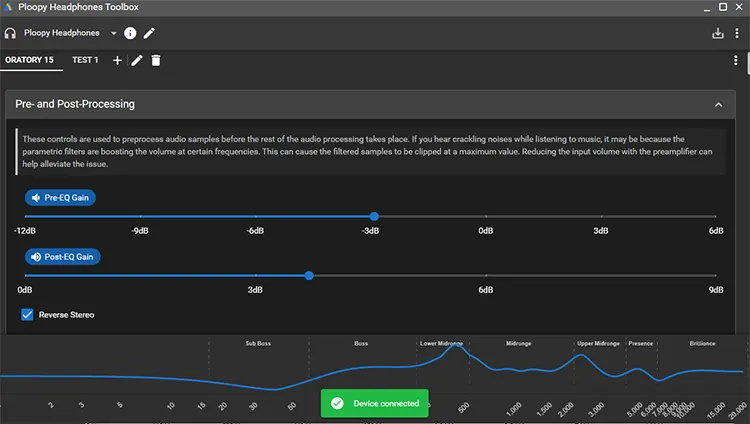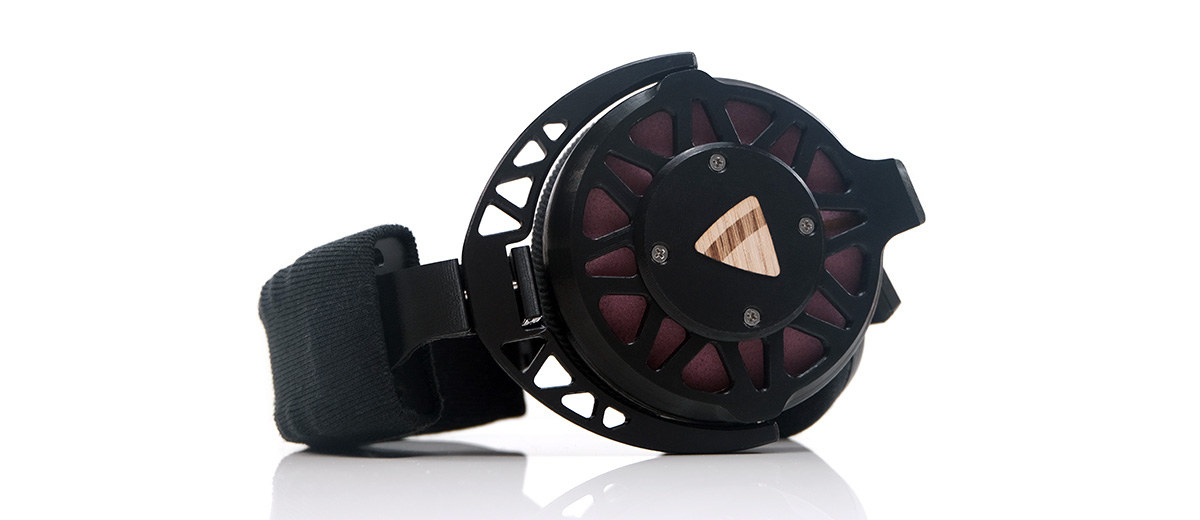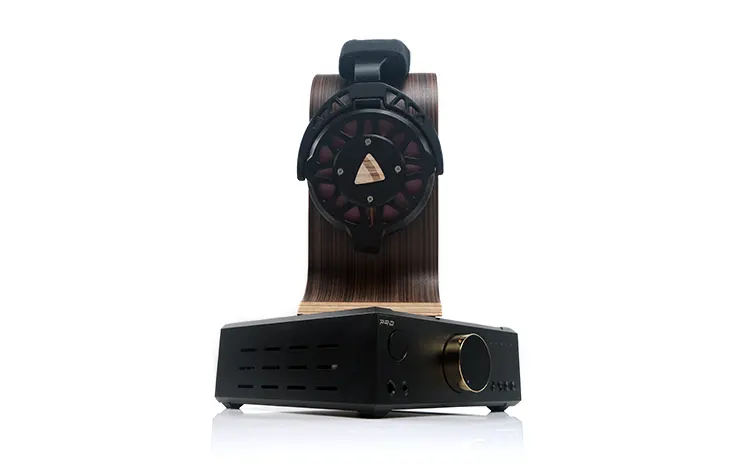Sound Impressions
The following sound impressions of the PLOOPY Headphones were completed with and without the accompanying USB DAC/amp. When without, it was paired with a FiiO K9 Pro ESS and also the Feliks Audio Envy SETA amplifier primarily due to its superior single-ended power output rating.
The PLOOPY USB DAC/amp firmware tested was PM15 which enhanced useable volume by around 6 dB over PM14.
Stock non-EQ Summary
In its stock tuning and without the accompanying DAC/amplifier, the PLOOPY Headphones presentation delivers a heavy V-shaped response curve that places a very strong level of amplitude on everything below 100Hz with some strong peaking also in the upper-mids and lower treble.
Everything in between is a little more sensible but with some dips around the edge of the upper bass and a lack of presence in the chest and/or male vocal region the general midrange clarity is overwhelmed by the power from the lows and highs.
In truth, the PLOOPY is unbalanced sounding without EQ with a heavy and very muddy bass bloom and a high potential for distortion on the lows, even with mild levels of gain applied.
Volume is a weak spot for the PLOOPY, even with EQ applied, given the driver’s low-efficiency levels so expect to hear all the pros and cons of these headphones at lower than average dB levels.
I will give the stock FR credit though for casting a very impressive macro-staging quality. The PLOOPY Headphones can sound very open and deep when you hit the sweet spot in terms of controlled dynamic peaks in any music playback and power/gain levels.
USB DAC/Amplifier PM15 Summary
All that changes once you connect the PLOOPY Headphones to the accompanying DAC/amplifier. It shapes up to something closer to a referenced target FR curve with a more sensible level of amplitude from the bass response and a bit more warmth and presence through the upper bass into the lower mids.
The upper mids and treble also sound more controlled and less peaky and thin sounding. This gives the PLOOPY a more serene and balanced sound quality, albeit still with a bit of weight and warmth on the lows.
Vocals and the mids in general benefit from less colored extremities and, in turn, deliver a more pleasing level of presence and clarity.
This is not a dry sound by the way. I compared them to both the Verum 1 and the HIFIMAN Deva Pro and found the general timbre to be more natural in tone and not as aggressive and forward sounding through the upper mids and lower treble.
The note body through the same region is a little lighter though than those two models and the general staging is just a few steps back in terms of perceived distance so that open and spacious quality that I quite like carries through.
I must preface the above though with two observations. The first is the amplifier’s output capability. It isn’t powerful enough to drive the PLOOPY Headphones to a high enough volume level.
The second is the fact that it has gone through some firmware updates with my tested version on PM15. Each firmware brings a different adjusted default FR to the table.
The PM15 is the warmest of the recent firmware updates with a bit more mid-bass to lower-mid bloom whilst keeping the sub-bass heavily shelved down to prevent distortion.

Toolbox PMEQ
There are two ways you can introduce EQ, (or PMEQ), into the PLOOPY Headphones tuning.
You can elect to keep it simple with the USB-powered PLOOPY DAC/amp and the Headphones toolbox software or via 3rd party EQ software using any DAC and amplifier of your choice.
The toolbox is an excellent tool to immerse yourself into PMEQ with 10 filter options over practically every frequency response point. You can target peaking, shelving, and multiple pass types as well as create your own IIR filter.
For the first timers, it might seem overwhelming but a handy graphic right at the bottom of the GUI keeps you informed of the exact FR changes your options are creating.
My very general recommendation is to target only major FR points and keep any Peaking and Quality values mild at the start. Don’t stray too far from gain options such as the one here from Oratory 15 until you are happy with your crafted FR. Big changes will throw your FR out of whack completely.

Alternative EQ
3rd party DACs and amplifiers will bring a bit of their characteristic into the sound signature. However, given the high amplitude of certain key areas of the PLOOPY Headphones stock FR, I did find myself aggressively targeting 50Hz and below across software platforms such as ROON and Foobar 2000.
Once you have dropped that region the potential for low-end distortion drops allowing you to carefully nudge up the volume levels a little more.
The example above is ROON’s MUSE PMEQ settings and as you can see the drop around 50Hz was up to 20 dB with a Q factor of 0.6 though in truth you can stretch to 0.3 depending on your preferences.
Two other minor adjustments included a gentle nudge around 2k of around 1-2 dB to compensate for a perceived minor drop here in the stock FR and a 0.5 dB drop around 6k to soften the treble slightly.
You can drop that treble peak further depending on your amplifier setup and preferences. I didn’t feel I needed to as my chosen amp has a warm character to begin with.
Synergy
Efficiency & Sensitivity
Officially, the PLOOPY Headphones are rated at 20Ω impedance with a sensitivity of 70 dB/mW.
Considering the likes of the HIFIMAN Deva Pro is rated at 91.1 dB/mW SPL and the closest ‘cottage-brewed’ headphone I have, the Verum 1, is 96 dB/mW you can quickly see where the major challenge of this headphone is.
This is not a very efficient or sensitive driver and it takes some really good quality power from any amp to get it moving to close to desired volume levels. Once you get there you quickly have to start managing any dynamic peaking in your signal because the limits the driver can accept are quite limited.
Much of that has to do with the stock frequency curve where narrow high-gain peaks leave little room on the sub-bass, (50Hz), upper mids, and some areas of the treble to drive the volume up without distorting or clipping.
Amplifier Pairing Examples
A good example was my pairing with the FiiO K9 Pro ESS which is rated between 1.1W, (16Ω) and 2.1W, (32Ω) with a maximum output voltage of >26Vp-p for its single-ended 6.35mm output.
Useable volume headroom quickly disappeared before the PLOOPY Headphones became remotely audible. Even with high gain selected, it was almost around 4 pm on the dial before you could settle down to listen to it. Any higher and distortion quickly crept in.
The Feliks Audio Envy gave me much more volume and current headroom to play with, (noon to 1 pm), with a power delivery of around 6-7W at 20Ω. I could also fine-tune with a selector front dial that controls the precise output voltage level.
Normally I go maximum on this dial with planars as it delivers the best mix of voltage and current but with the PLOOPY headphones, the medium level was smoother sounding.
You do not have to spend that much to match an amp to the PLOOPY headphones. Rather the message here is to ensure any SE output you pair it to has excellent output power capability. Based on my findings I suspect something like the SMSL H300 which Aldous reviewed recently could fit the bill here.





